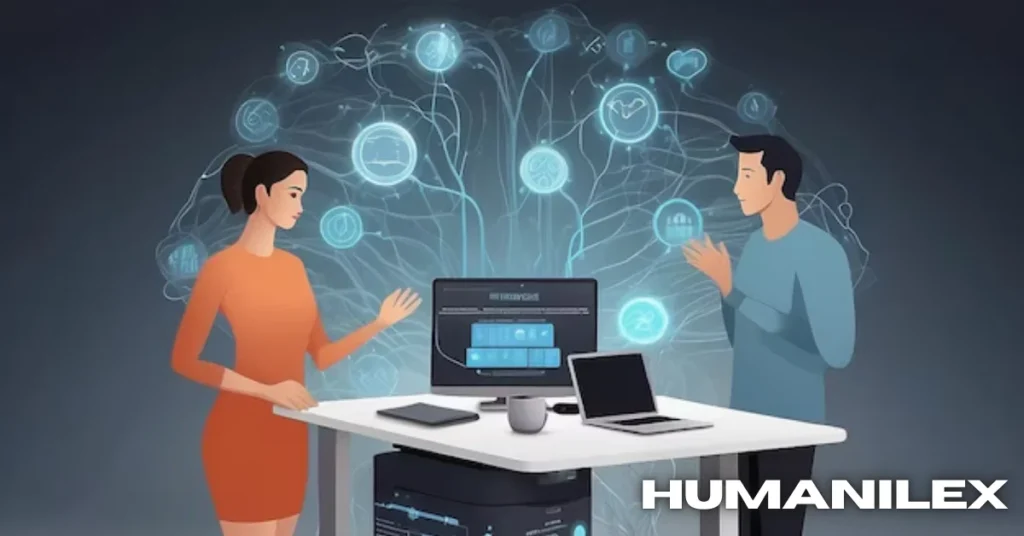Introduction to Humanilex
Imagine a world where interacting with technology feels as natural as having a conversation with a friend. Enter Humanilex, an innovative platform that is set to change the way we communicate with our devices. In an era where digital interfaces often feel cold and mechanical, Humanilex introduces warmth and understanding into human-computer interaction. This groundbreaking approach promises not only efficiency but also genuine connection in our tech-driven lives.
As we delve deeper into this transformative concept, we’ll explore why traditional methods of interaction fall short and how Humanilex stands poised to lead us into a new age of communication—one that values empathy alongside functionality. Get ready to discover what makes Humanilex more than just another tech tool; it’s about redefining the relationship between humans and machines for good.
Understanding Human-Computer Interaction
Human-Computer Interaction (HCI) is a fascinating field that explores how people interact with computers and technology. It blends knowledge from computer science, cognitive psychology, design, and social sciences to create intuitive user experiences.
At its core, HCI aims to bridge the gap between humans and machines. This involves understanding human capabilities, limitations, and behaviors while designing systems that cater effectively to these insights.
As technology evolves rapidly, the complexity of interactions increases. Users expect seamless connectivity across devices and platforms. Designing for this requires not just technical skills but empathy—grasping users’ emotional responses during their interactions.
Effective HCI promotes accessibility too. It’s about ensuring everyone can utilize technology regardless of their background or abilities. The future lies in crafting more personalized experiences based on individual needs and preferences.
The Need for a More Humanized Interaction
The digital age has transformed how we communicate. Yet, something crucial is missing. Many interactions with technology feel cold and detached.
As artificial intelligence becomes more prevalent, users crave a connection that mirrors human empathy. Rigid responses from machines can lead to frustration, as they lack the nuances of real conversation.
People want tools that understand their emotions and adapt to their needs. A robotic reply simply doesn’t cut it anymore.
This desire for deeper engagement drives innovation in user interfaces and conversational design. Users expect tech to be responsive and intuitive, creating an experience that feels personal rather than transactional.
Humanilex embodies this shift by fostering interaction styles reminiscent of natural human dialogue. By bridging the gap between man and machine, we redefine what it means to connect in our increasingly digital world.
How Humanilex is Changing the Game
Humanilex is reshaping the landscape of human-computer interaction. By prioritizing natural communication, it creates a seamless dialogue between users and machines.
This platform leverages advanced AI to understand context, emotions, and nuances in language. Such capabilities allow for more intuitive exchanges that feel less mechanical.
Imagine asking your device complex questions without worrying about misinterpretation. Humanilex makes this possible by evolving beyond traditional command-based systems.
Its user-friendly interface encourages creativity and exploration. Users can engage with technology in ways previously thought impossible.
Moreover, accessibility has become a core focus. Humanilex caters to diverse audiences, making tech interactions smoother for everyone—from children to seniors.
As we embrace these advancements, the potential applications are endless—transforming industries one conversation at a time.
Key Features and Benefits of Humanilex
Humanilex stands out with its innovative features designed to enhance user experience. Its intuitive interface allows for seamless navigation, making it accessible for all users, regardless of tech-savviness.
One key benefit is its adaptive learning capability. Humanilex learns from individual interactions, tailoring suggestions and responses to fit user preferences and needs. This personalization fosters a deeper connection between the user and technology.
Additionally, the platform emphasizes natural language processing. Users can communicate in everyday language rather than relying on rigid commands or technical jargon. This creates a more fluid interaction that feels less robotic.
Security is also paramount with Humanilex. Advanced encryption protocols ensure that personal data remains protected, building trust among users.
Collaboration tools enable teams to interact efficiently within the software while boosting productivity through streamlined workflows. Each feature contributes to a more human-centric digital landscape.
Real Life Examples and Case Studies
One standout example of Humanilex in action is its use in healthcare. Hospitals have integrated the platform to streamline communication between patients and medical staff. The conversational interface allows users to ask questions about treatment plans or medications easily. Patients appreciate this personalized touch, leading to improved satisfaction rates.
In education, schools are leveraging Humanilex for interactive learning experiences. Teachers can create customized lesson plans that adapt based on student responses. This dynamic interaction fosters deeper engagement among learners and enhances comprehension.
Another compelling case is found in customer service sectors. Companies are implementing Humanilex-powered chatbots to provide 24/7 assistance. These bots not only resolve queries but also learn from interactions, becoming more efficient over time.
These real-life applications illustrate how Humanilex transforms traditional processes into intuitive experiences across various industries, showcasing its versatility and impact.
The Impact of Humanilex on Society
Humanilex is reshaping how we interact with technology on a societal level. It fosters deeper connections between users and machines, making digital experiences more intuitive.
This innovation enhances accessibility for diverse populations. People with disabilities can now engage more fully with technology that understands their unique needs.
Education also benefits significantly. Students find learning tools that adapt to their individual styles, encouraging better retention and engagement.
In the workplace, Humanilex streamlines communication and collaboration. Teams work smarter together when interfaces respond in human-like ways, boosting productivity.
Moreover, it influences mental health positively by reducing frustrations commonly associated with traditional systems. Users experience less anxiety when interacting with responsive technologies designed to understand them.
The ripple effect of these changes creates a society where technology feels like an ally rather than a barrier. The potential for growth within communities is enormous as Humanilex continues its journey forward.
Challenges and Future Possibilities
Humanilex faces various challenges as it continues to evolve. One major hurdle is ensuring seamless integration with existing technologies. Many users are accustomed to traditional interfaces, making the transition daunting.
Privacy and security concerns also loom large. As Humanilex harnesses data for personalization, safeguarding user information becomes crucial. Balancing innovation with ethical practices will be key to gaining trust.
Looking ahead, the potential for Humanilex is immense. Imagine a world where computers understand emotions and context better than ever before. The possibilities in education, healthcare, and customer service could transform industries entirely.
Moreover, advancements in AI research can enhance Humanilex’s capabilities further. Natural language processing may allow machines to comprehend nuanced human expressions more accurately.
Collaboration between tech developers and researchers will pave new paths forward. With collective effort, we can unlock avenues that make human-computer interaction even more intuitive and enriching.
Conclusion
Humanilex is paving the way for a future where technology feels more like an extension of ourselves rather than just machines we interact with. By embracing the essence of human communication and understanding, it bridges the gap between humans and computers in ways we never thought possible.
As society continues to evolve digitally, Humanilex stands at the forefront of this transformation. Its innovative approach not only enhances user experience but also fosters deeper connections through technology. The insights gained from real-life applications demonstrate its potential to change industries across various sectors.
With challenges still ahead, such as ensuring privacy and security while promoting inclusivity, there are exciting prospects on the horizon. As developers continue to refine Humanilex’s capabilities, it holds promising implications for our daily lives and societal interactions.
Embracing tools that prioritize human connection can lead us toward a more harmonious relationship with technology. With Humanilex leading this charge, we may soon find ourselves navigating digital landscapes that feel as intuitive as conversing with a friend.
FAQs
What is “Humanilex”?
Humanilex is an innovative platform designed to enhance human-computer interaction by creating a more natural and empathetic communication experience between users and technology.
How does Humanilex improve user experience?
Humanilex uses advanced Natural Language Processing and adaptive algorithms to understand context and emotions, making interactions feel more intuitive and personalized.
What industries can benefit from Humanilex?
Humanilex can transform various sectors, including healthcare, education, business, and gaming, by promoting accessibility and enhancing user engagement.
What are the key features of Humanilex?
Key features include an intuitive interface, adaptive learning capabilities, robust security measures, and natural language communication that allows users to interact without rigid commands.
What challenges does Humanilex face?
Humanilex faces challenges such as ensuring seamless integration with existing technologies and addressing privacy concerns while fostering user trust in its personalized services.







